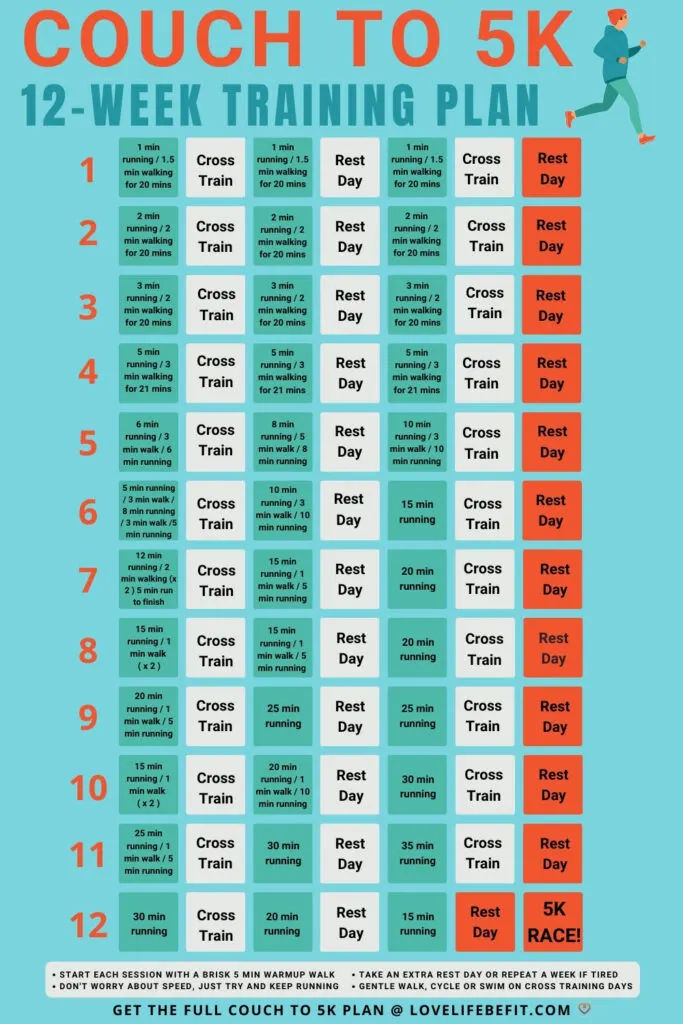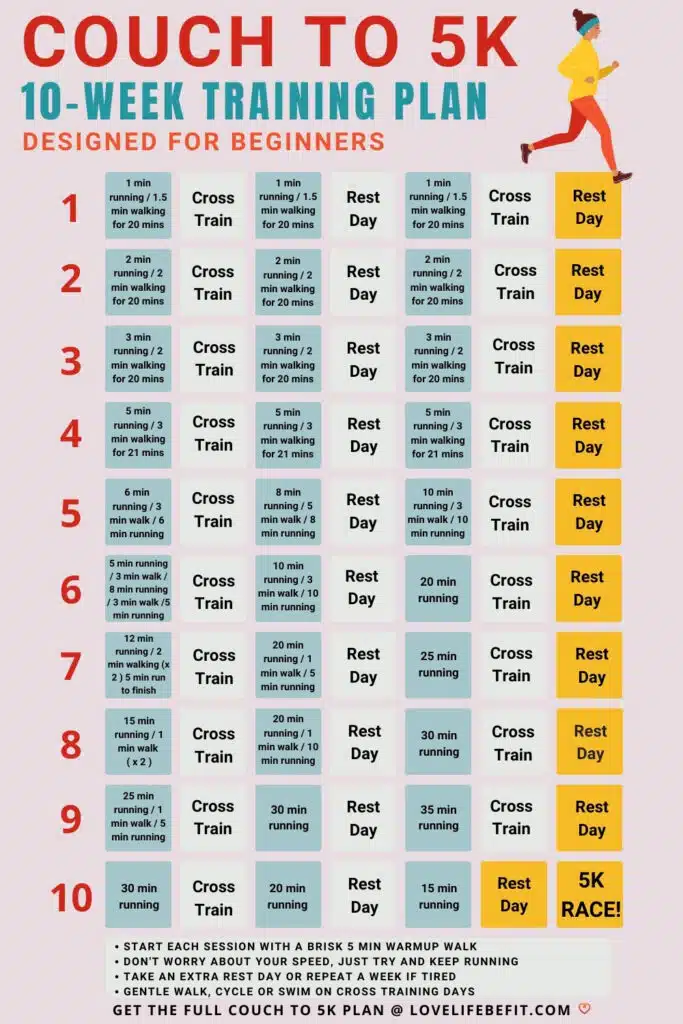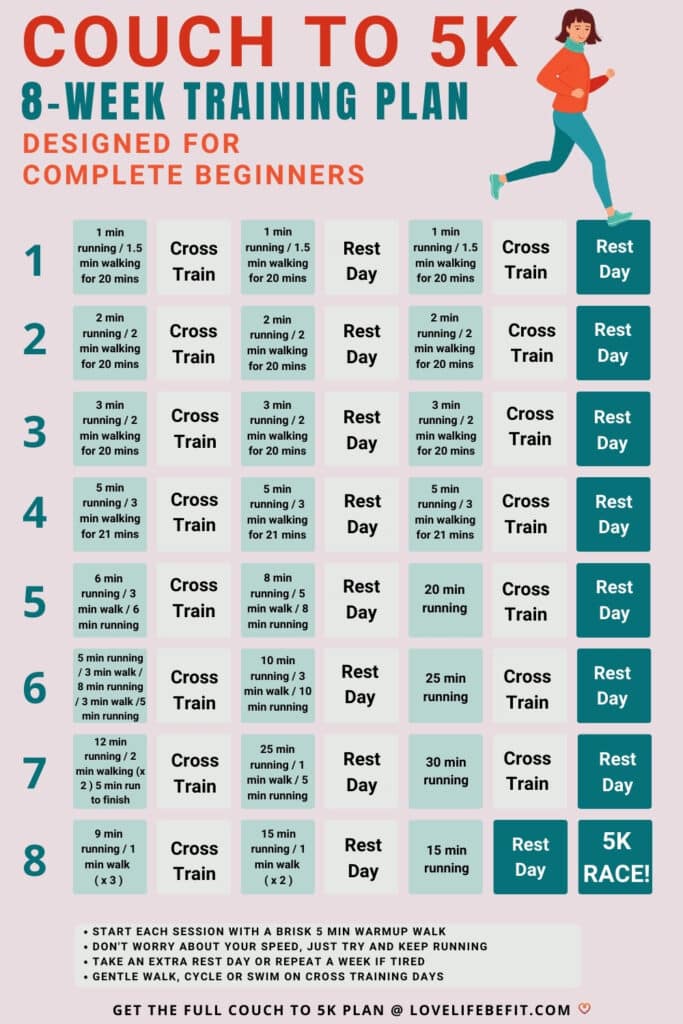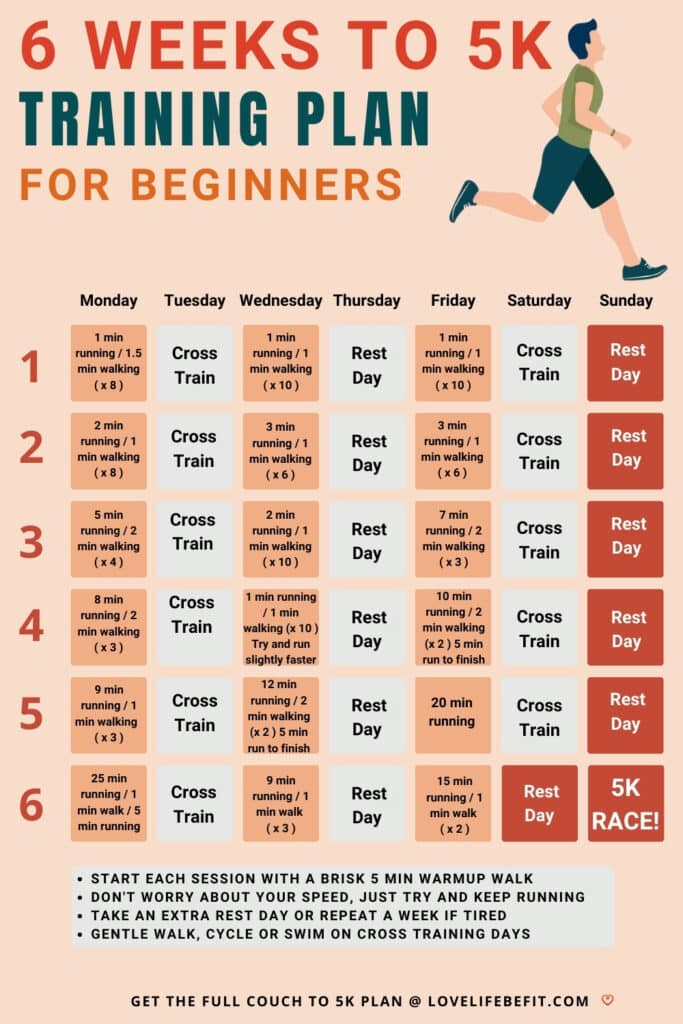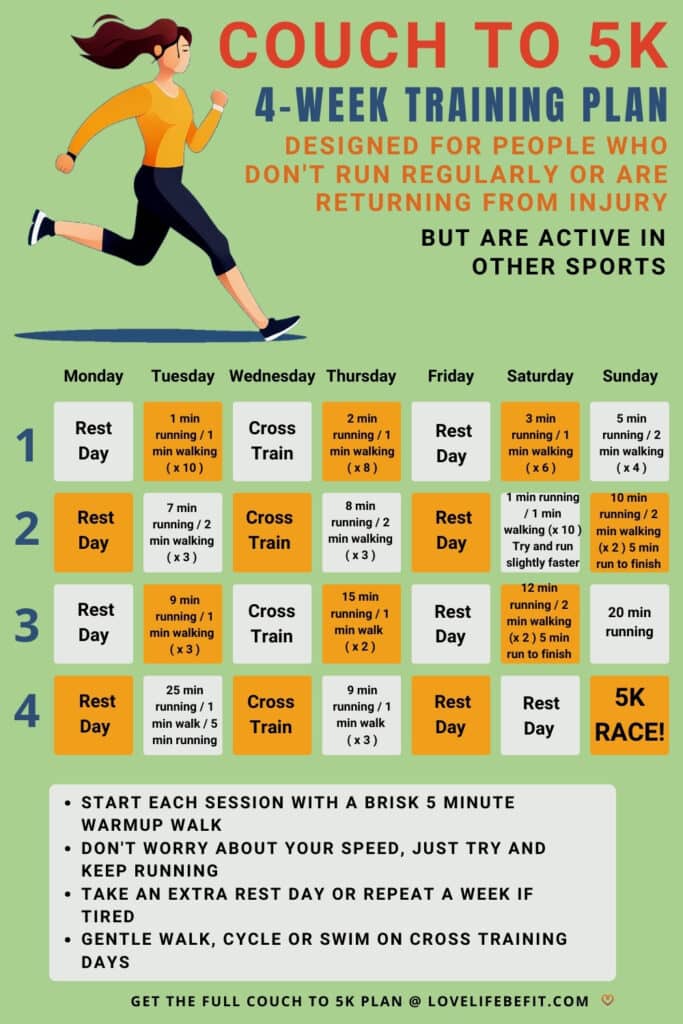Ready to train for your first 5K? Couch To 5K Plan is the most popular training plan for beginner runners. It’s a gentle introduction to running and it works. If you haven’t run since childhood and dread the thought of lacing up a pair of running shoes, this is the plan for you.
We can’t guarantee that Couch To 5K will make you fall in love with running, but it’s the best shot for absolute beginners to complete a 5K run. So what is it? How do you start Couch To 5K and how long does it take?
This complete running guide will tell you everything you need to know about going from Couch To 5K.

The Couch To 5K Training Plan
This is based on the original 9-week standard Couch To 5K training plan with just a few minor adjustments:
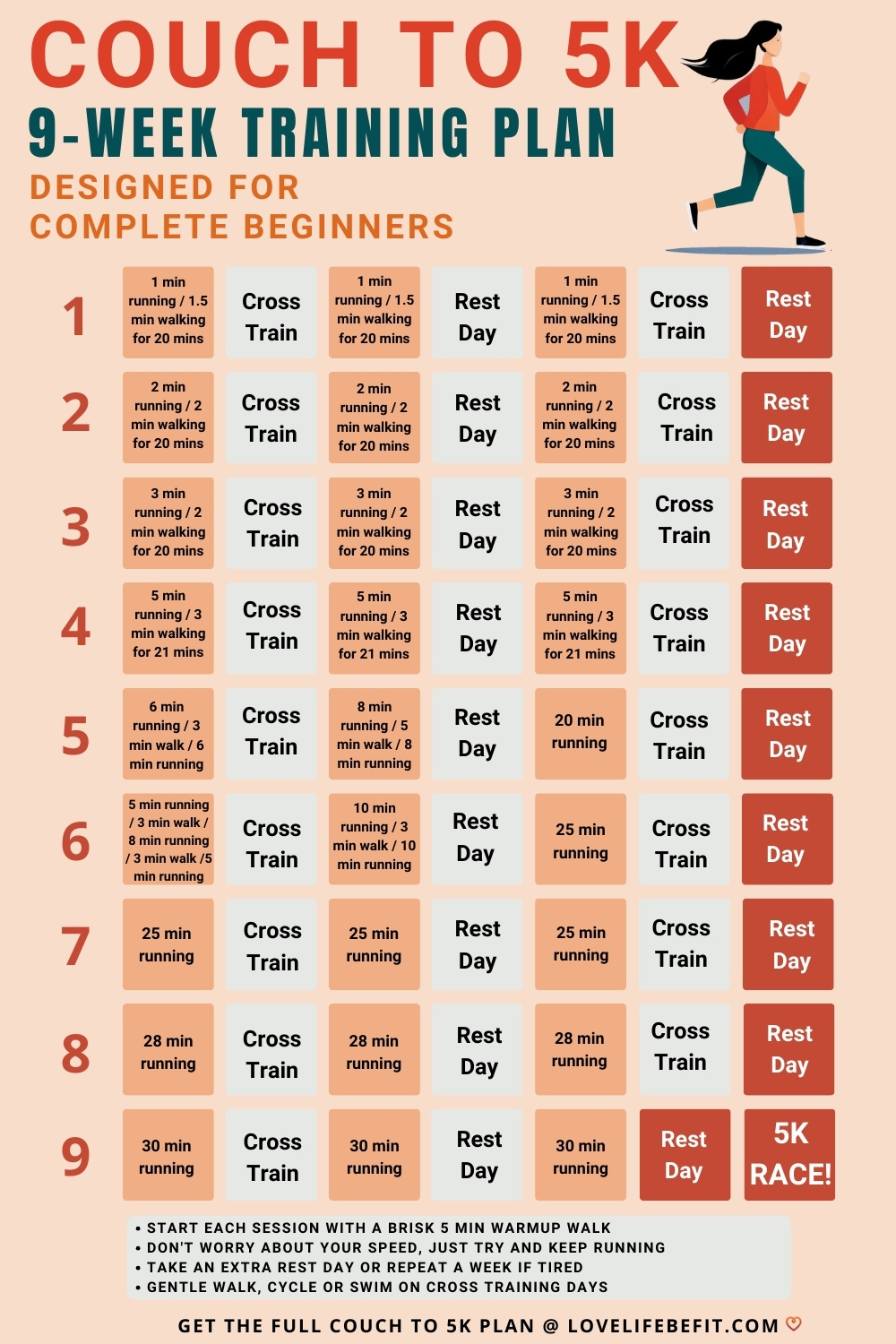
What Is Couch To 5K Or C25K?
Couch To 5K, sometimes abbreviated to C25K, is a simple but effective training plan developed in the 90s by Josh Clark. The aim is to help complete beginners start running and go from couch to 5K.
Clark didn’t have a background as a coach. He was a new running convert who understood just how hard it can be to transition from walking to running. The story goes he wrote the plan for his Mum and she loved it!
Couch To 5K has been immensely successful. It’s the official exercise plan of the British National Health Service and over 6 million runs were logged on the free NHS Couch To 5K App in 2022. Most people will know someone who’s completed C25K.
Its success lies in its simplicity. This is a running plan for ordinary people. To make starting to run as pain-free as possible.
You may start running to lose excess weight or to deal with other issues. The challenge and structure of a running plan can be a cure-all and distraction for the stresses and strains in life.
But somewhere along your running journey, we hope you’ll get a thrill out of the pure physical sensation of making your body move. That’s why people run.

How Far Is 5K?
In case you’re not used to the metric system, 5K in miles is 3.1 miles. The “K” stands for kilometers.
It’s a distance everyone can manage. You don’t need to run fast, you just need to keep going – one step at a time.
It’s a great first target for new runners. A gentle introduction. Training for a half marathon or further puts a lot of strain on your body.
With 5K training, you’ll recover quickly from your runs and can combine running with other good habits for a healthy lifestyle. There’s also less injury risk as you gradually build your running distance.
How Long Does Couch To 5K Take?
The original Couch To 5K plan takes 9 weeks. For some people that’s too slow and for others, it’s too fast.
It really depends on your starting fitness level. If you already take part in other sports or walk regularly, six weeks or even four weeks may be all it takes to train for a 5K.
For others, who haven’t exercised regularly in years, C25K will take a little longer. That’s why we have a 12-week plan for absolute beginners.
This post includes all our recommended Couch To 5K training plans: 4 weeks, 6 weeks, 8 weeks, 10 weeks, and 12 weeks.
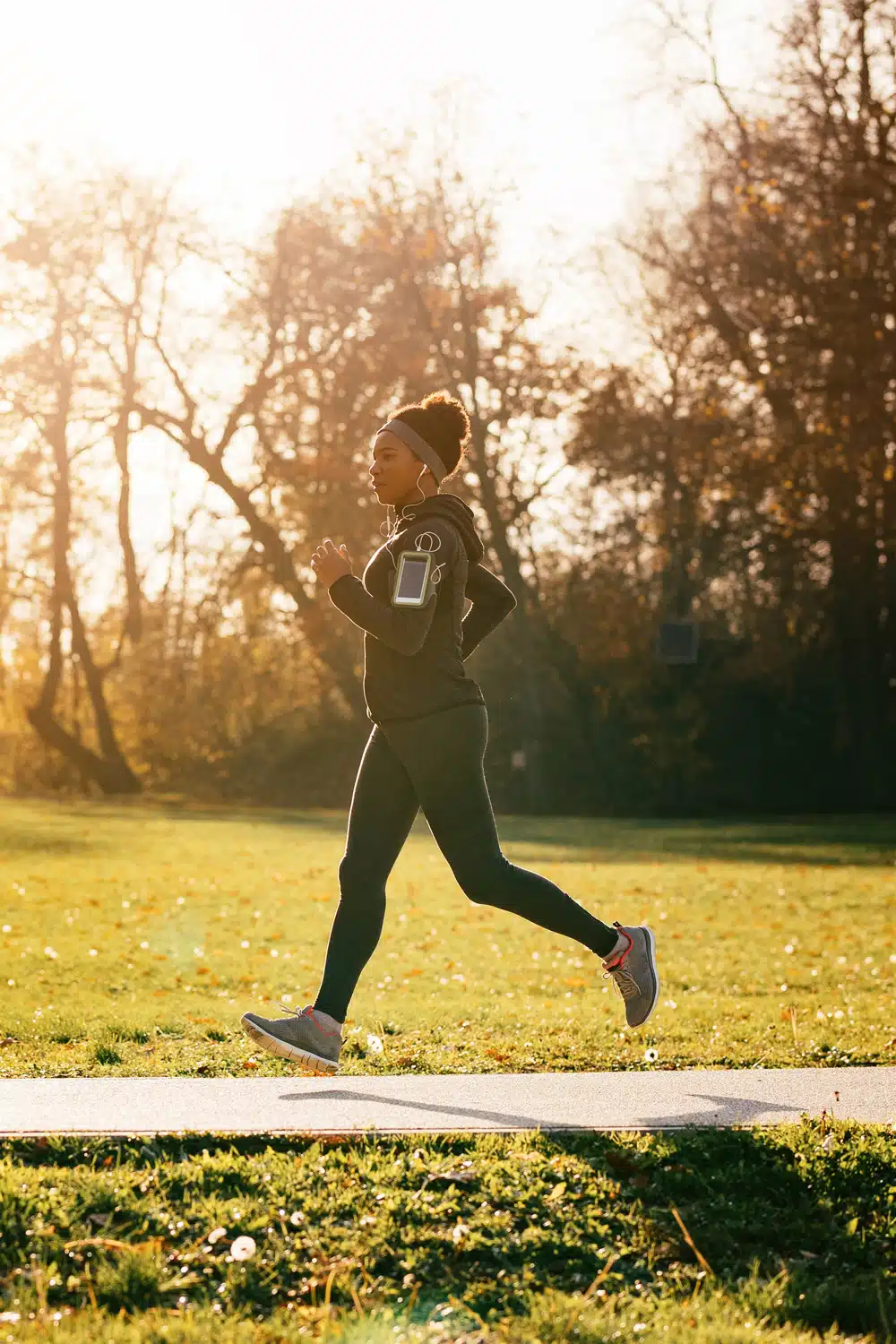
How Does The Couch To 5K Plan Work?
C25K has successfully helped millions of people start running. People who never thought they’d be runners. There’s no upper age limit and it’s a plan for everyone whatever your size or shape.
The key to C25K is interval training. The plan uses running intervals with walking breaks to ease you into consistent running.
Running And Walking Intervals
Until Couch To 5K came along, beginner runners were encouraged to run as far as possible without stopping. I know from my own experience this was painful. You’d run until you were forced to stop, doubled over and gasping for breath!
With the Couch To 5K training plan, in the first few weeks, the running intervals are really short. Before you start to struggle, it’s time for a walking break. As you get fitter and progress through the plan, the time spent walking reduces and the running sections get longer. You’ll run further and further without stopping.
The Advantage Of Intervals
The run/walk approach isn’t just great for easing you into running:
- Interval training gets you fitter faster – you will typically run faster on the running sections than if you run further at a slower pace. This gives you a better cardio workout.
- You’ll have better running form – when you get tired you quickly lose your running form, your hips sag and you land heavily on your feet. With a walking break to aim for, you can run with good form and recover in the walking sections.
- You’re building stamina – those walking breaks will help you keep going for longer. You’re spending more time on your feet and building endurance.
It’s A Time-Based Plan
Traditionally, running plans are based on distance. Everyone covers the same distance no matter how fast or slow they run.
This puts slower runners at a big disadvantage – they end up running for a lot longer and are more likely to get injured or just become disheartened.
Couch To 5K is different, it’s a time-based training schedule. This means the running and walking intervals are set in minutes rather than miles or kilometers (km).
It doesn’t matter how fast you run, as long as you keep going for the specified amount of time. This makes it much more accessible to everyone regardless of their level of fitness.
Why Is The Couch To 5K Plan So Popular?
Word of mouth and a fledgling internet helped to grow the plan’s popularity back in the 90s. The catchy name must have helped. But there are some solid reasons why the training program is so popular:
- It’s simple. Just 3 running sessions a week, clearly defined and easy to follow.
- It’s flexible. The plans suggest training days but it’s really up to you. Create your own running routine and fit in the sessions on the days when you have time to train.
- Pain-free. Okay, there are no guarantees, but the run/walk approach keeps pain to a minimum!
- The training plan works for just about everyone. Even people who thought they would never be runners have completed the plan.
- It has a goal. It’s always better when you have a goal to aim for. Sign up for your first race and start training!

How Long Does It Take To Run 5K?
When you’re running your first 5K, try not to compare yourself with other people or stress about your running time. The aim is to complete the distance on race day, hopefully without stopping.
For most people running is a competition with yourself. When you run your next 5K you can try and improve your personal record (PR). Completing your first 5K will be a benchmark and should be celebrated!
Beginner runners typically take 30 to 40 minutes to run 5K but age, gender, and fitness level can make a big difference to those finish times. If it takes you 45 minutes or more, it’s still a massive achievement. Find out more about average 5K running times.
Will I Lose Weight Doing Couch To 5K?
Couch To 5K isn’t a weight loss plan. It’s a plan to improve your fitness and get you to the finish line of a 5K.
Running does burn fat and some exercise is essential if you want to lose weight and keep it off. But Couch To 5K weight loss is only possible if you combine your training with improving your diet.
When you go for a short run you can easily replace the calories burned running with a few sweet treats. The key to losing weight is eating a healthy diet.
Combine running regularly with a diet of lean protein, whole grains, vegetables, some fruit, and small amounts of healthy fats. When you’re running for weight loss, avoid processed foods high in fat and sugar.
How Fit Do You Have To Be To Do Couch To 5K?
If you show up for training you’re probably fit enough to complete Couch To 5K. The run sections are very short in the beginning – just 60 seconds.
All you have to do is push yourself a little faster than walking pace. It could be a jog or even power walking. You will still benefit from the training sessions.
To get the most out of the plan, it’s best if you can walk briskly for 20 minutes before starting. Briskly just means at a pace where you’re making an effort but you can still walk and talk.
If you’re carrying a lot of excess weight, it’s best to start with a walking schedule. Running is a high-impact activity and too much excess weight increases the risk of injury.
Our Couch To 5K Walking Plan is a better option until you’ve built up some leg strength and shed a few pounds.
Check-in with your doctor before starting Couch To 5K if you haven’t exercised in years, if you’re carrying a lot of extra weight, or if you have pre-existing medical conditions.

Couch To 5K Advice From A Running Coach
There are a lot of things I like about Couch To 5K. We’ve already talked about its simplicity and it’s hard to knock a plan that’s introduced so many people to running.
Assessing the plan as a running coach, there are a few things that could be better:
#1 9 Weeks Is The Wrong Length
The original Couch To 5K Plan is 9 weeks long. That’s a bit like saying everyone following the plan is starting from the same fitness level.
Of course, that’s not the case! There’ll be people following the plan who have a lot of residual fitness from other sports, or from active jobs, or just because they’re young.
For these people, a 9-week plan is far too long to train to run 5K. Some people can show up at a 5K race with no running experience or training and still get around the course! We don’t advise it but it does happen. Our 4-week and 6-week plans are aimed at these beginners.
For other people, a 9-week plan is too short. You can always repeat weeks and take extra rest days but that can be a little demoralising. It’s better to follow a plan that takes things slow.
Our 10-week and 12-week plans give you extra time to build up to tougher sessions such as your first continuous 20-minute run and extra time to build up your fitness ahead of race day.
#2 Cross Training
Back in the 90s, cross-training wasn’t a thing. It wasn’t common knowledge that if you cross-train on some of your rest days it helps your running fitness.
Our own Couch To 5K plans include cross-training workouts once or twice a week. Find out more about the benefits of cross-training for runners.
#3 Strength Training And Mobility
The key to long-term physical health is strength training and mobility exercises. And you’re never too young to start!
Running is a repetitive action in one plane of motion. It’s great for cardio but runners can be some of the most inflexible people I know!
Add some strength and mobility exercises after your training runs and your body will thank you. It will help prevent injuries and the increased mobility will improve your running form.
These bodyweight exercises for runners are ideal. Just two short 10 to 15-minute sessions every week will make a big difference to your running.
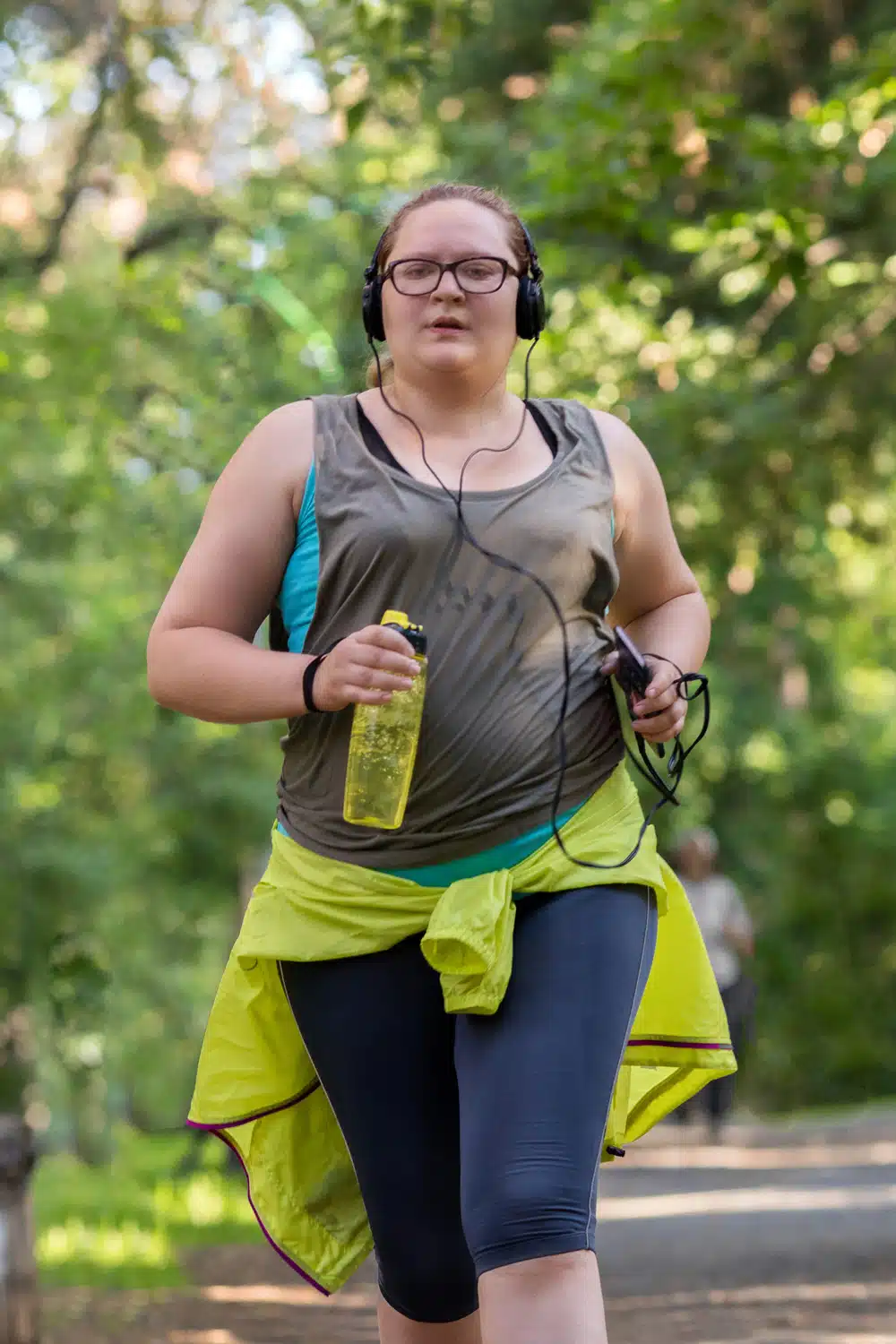
Our Couch To 5K Training Plans By A UESCA Certified Running Coach
Choose a training plan that matches your current running ability and fitness level.
Couch To 5K 12-Weeks
A plan for complete beginners with very little running experience. If you can walk for 20 minutes at a brisk pace, you’re fit enough to complete the first training session.
The weekly schedule includes 3 running workouts, 2 cross-training days, and 2 rest days.
Couch To 5K 10-Weeks
Progress is a little faster than the 12-week plan but there’s still plenty of time to adapt to running.
This weekly schedule for complete beginners includes 3 running workouts, 2 cross-training days, and 2 rest days.
Couch To 5K 8 Weeks
This is still a plan for complete beginners but it helps if you have some fitness from other sports.
The weekly schedule includes 3 running workouts, 2 cross-training days, and 2 rest days.
Couch To 5K 6 Weeks
If you’re a beginner runner, this 6-week plan will be challenging but possible. It will help to have some fitness from other sports.
The weekly schedule includes 3 running workouts, 2 cross-training days, and 2 rest days.
Couch To 5K 4 Weeks
This 4-week schedule is for occasional runners or people with some fitness from other sports. It’s also a good plan to use if you’re returning from injury.
The weekly schedule includes 4 running workouts, 1 cross-training day, and 2 rest days.
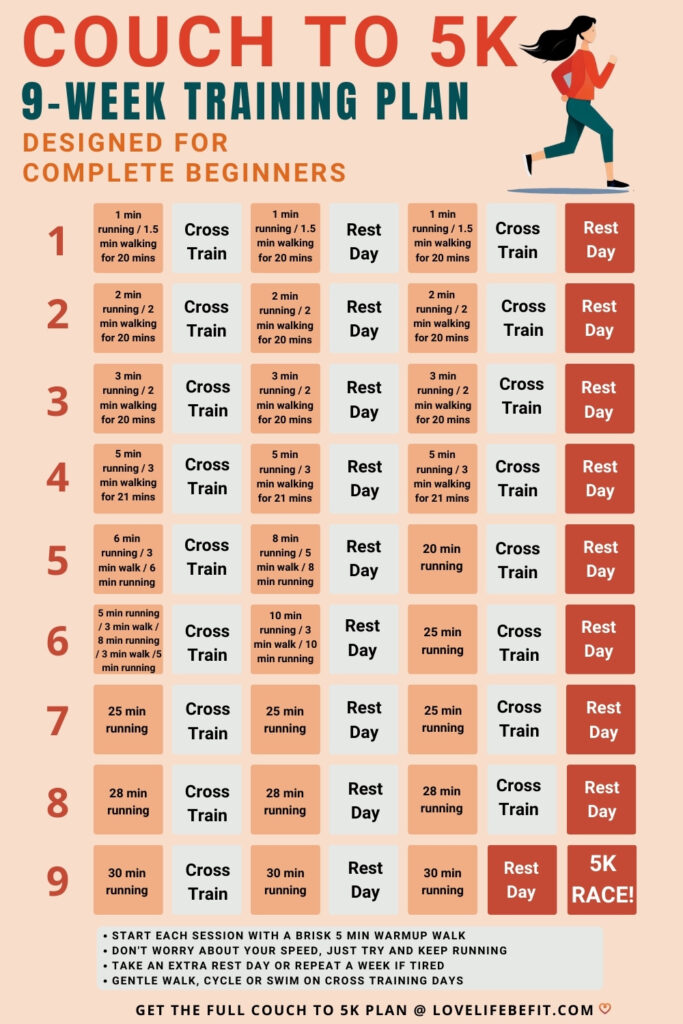
Couch To 5K 9 Weeks
The original Couch To 5K program with just a few adjustments.
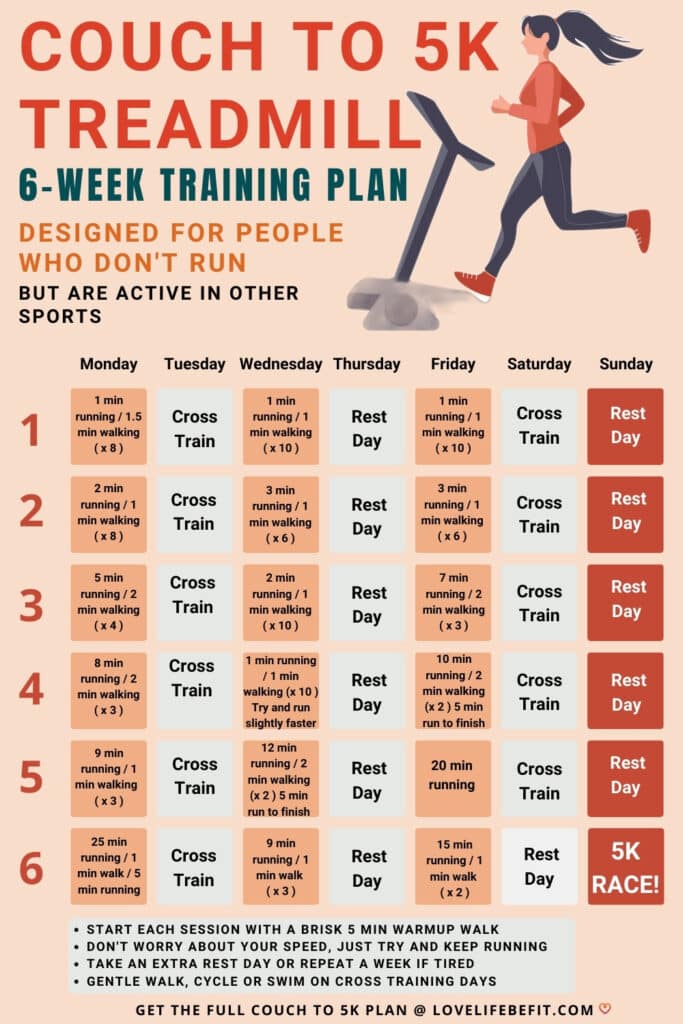
Couch To 5K Treadmill
A complete guide to Couch To 5K on a treadmill with 6-Week and 9-Week Couch To 5K Plans
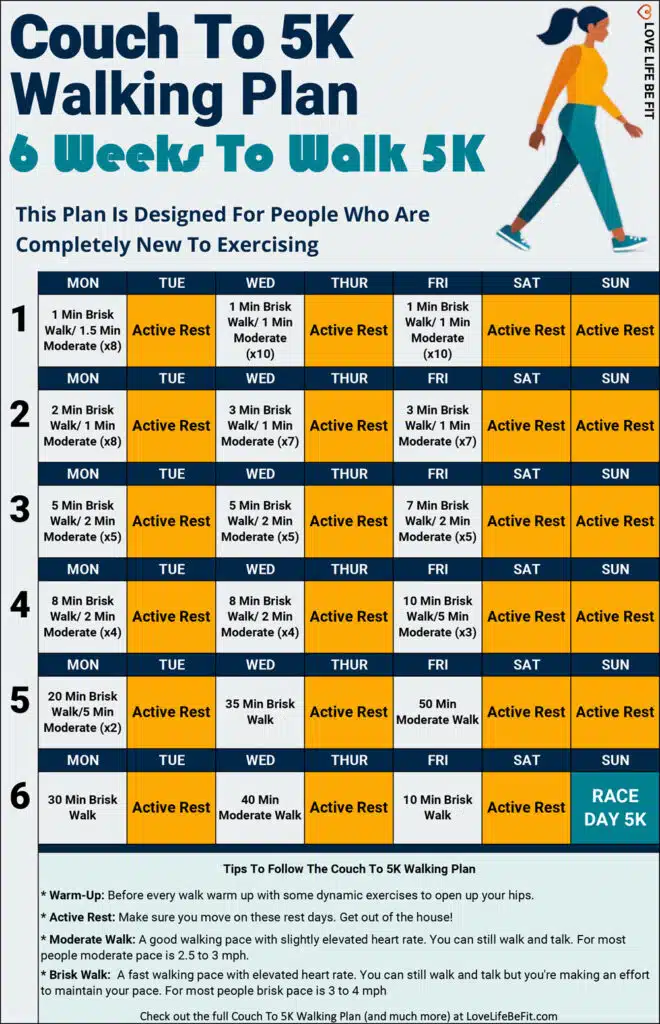
Couch To 5K Walking Plan
Our Couch To 5K Walking Plan is a good way to improve your fitness. Follow our walking plan before advancing to a Couch To 5K Running Plan.
The following guidance notes apply to all plans:
Warm Up
Always warm up before you start a running session. Start with a 5-minute brisk walk and preferably some dynamic stretching.
Your First Run
Don’t worry about your speed. Just try and run continuously for the full running interval. If you’re red in the face and struggling to breathe, slow down.
Get To The Ninth Run
Even if you think you hate running, keep following the training program. Get to the ninth run – the end of the first 3 weeks. It’s normally a turning point.
By this stage, you’ll notice you’re making progress. Running won’t feel quite so hard. You may even enjoy it!
If You Feel Sore
Some aches and soreness are to be expected but if you still feel sore at the end of your warm-up – take a rest day.
If the aches persist, get checked out straightaway by a physiotherapist. Actual pain is a big red flag. If you feel pain, don’t continue running.
Cross Train
The plans include cross-training sessions. Aim for 30 minutes of walking, cycling, swimming, yoga… or any activity you enjoy.
Rest Days
Don’t skip your rest days. Your body needs time to recover and repair before your next training session. It’s important to avoid injury. Find out more about rest and recovery.
Repeat A Week
If you find you’re struggling, repeat a week or take an extra rest day. Alternatively, switch to a different plan.

Tips To Complete Couch To 5K
These tips will help you get the most out of your training and help you avoid common Couch To 5K mistakes from the steps you need to take before your first run to how to prepare for race day.
#1 The Basics
You’ll find a lot of advice on this site for new runners. Here are some tips to cover the running basics:
Running Shoes
A good pair of running shoes is essential. These shoes need to be comfortable, supportive, and fit correctly.
It’s best to buy your first pair of running shoes in-store from an independent retailer. A good store will be able to assess your gait and recommend suitable shoes. Find out more about Running Shoes for Beginners.
Clothing And Kit
There’s a good chance you have fitness clothing lurking in the back of your cupboard that’s suitable for running. All you need are shorts or leggings and a T-shirt or vest.
Most of the training sessions are around 30 to 40 minutes in length. It’s not long enough to worry about chafing and the need for moisture-wicking fabrics. I ran for years in a cotton T-shirt when I first started running!
Women do need to invest in a good high-impact sports bra. It can get very uncomfortable running without one. Find out more about What To Wear Running.
Running Form
Your running form on Day 1 won’t be great but it will improve as your plan progresses and your body adapts to running. The best tip when you first start to run is to try not to overstride.
When you run land with your feet under your body and not out in front. This one tip will stop you from slamming your heels into the pavement.
Breathing
If you’re struggling to breathe when running, there’s a good chance you’re trying to run too fast. The main tip is to breathe from your gut – it’s called diaphragmatic breathing.
It provides more space for your lungs to expand. More space means greater lung capacity and more oxygen-rich blood flowing to your hard-working muscles. Less gasping for air when you’re running.
Running Speed
Pacing is difficult for all runners, especially beginners. You’ll be surprised by how slowly you need to run during these training sessions. Find out more about how fast should I run and tips to find the right pace.
Treadmill Or Outside
Runners mainly prefer to run outside but you can easily train for a 5K on a treadmill. Our Couch To 5K Treadmill Plan is full of advice for taking your training indoors.

#2 Motivation
Of course, a personal trainer would be ideal! But there are other ways to make sure you keep showing up for training sessions:
- Set aside a regular training time in your schedule. Give it a high priority!
- Pin your plan somewhere where you can see it every day and cross off the sessions as you complete them.
- Find another new runner to train with – you can keep each other accountable.
- Reward yourself. Every time you hit a new running goal celebrate. Get some ideas from these non-food rewards.
#3 Fueling Your Runs
We’ve already discussed that Couch To 5K isn’t a weight loss plan but if you’re trying to lose weight, running will help.
The best approach is fueling your body with the good nutrition you need to run while cutting back on all the junk that just adds calories and inches to your waistline.
By junk, we mean highly processed, high-fat, and high-sugar food. It may taste great but it’s not doing much for your body.
There’s a misconception that you need to eat a big pre-training snack before running and top up during your run with high-energy drinks and gels.
This is completely unnecessary. If you’re trying to lose weight, you don’t need the extra calories. Most people can complete the training sessions without any extra food and can hydrate with water.
If you’re running in the morning try running fasted or just have a small snack such as a banana before you run. You can eat your normal healthy breakfast when you finish training.
You may need electrolytes to rehydrate if you’re running in a very hot country. Just choose the ones without added sugar. For most runners, water is adequate for short runs.
#4 Race Day
We’d love to see you take part in your first race so don’t talk yourself out of it! Don’t worry about being slow. Everyone taking part in the race was once in your shoes – lining up at the start line of their first race!
The only person you’re competing with is yourself. If you are last – and we doubt you will be – you’re guaranteed to get the biggest cheer! 5K races are normally fun events full of beginners just like you.
Make sure you get to the start in plenty of time to warm up and find the toilets! Take along a friend to cheer you on and make sure you have a dry top, a healthy snack, and a drink for after the race.
Set off at a steady pace – not too fast. Remember to enjoy yourself and take lots of photos!

What To Do After Couch To 5K
Finished your first 5K? It’s time to set your next running goals.
You could enter another 5K race and try to improve your time with our Intermediate 5K Training Plan or step up your distance. Many runners decide to run further for their next challenge. Give these plans a try:
Download Our 4-Week, 6-Week, 8-Week, 10-Week, and 12-Week Couch To 5K Plans For Free.

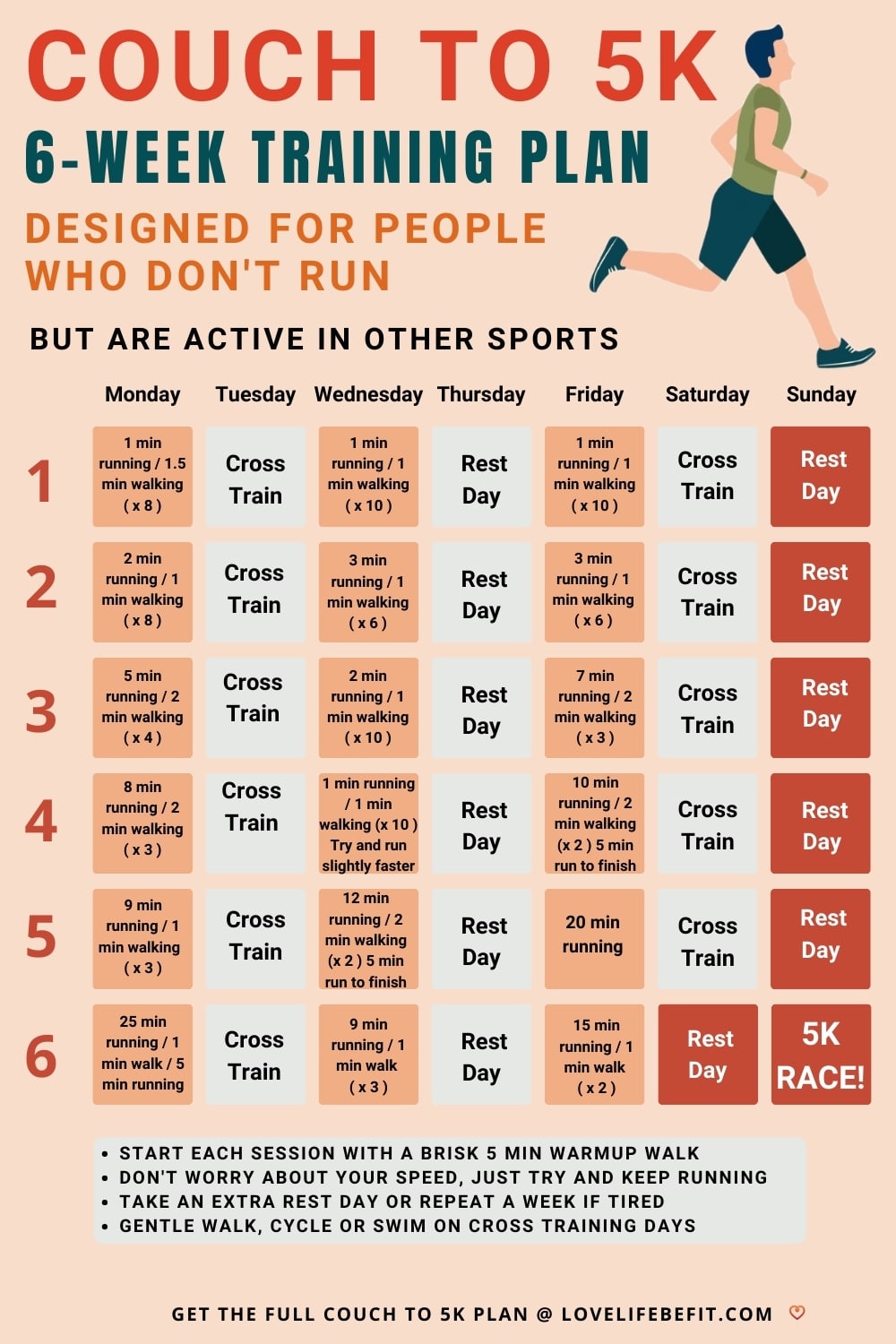
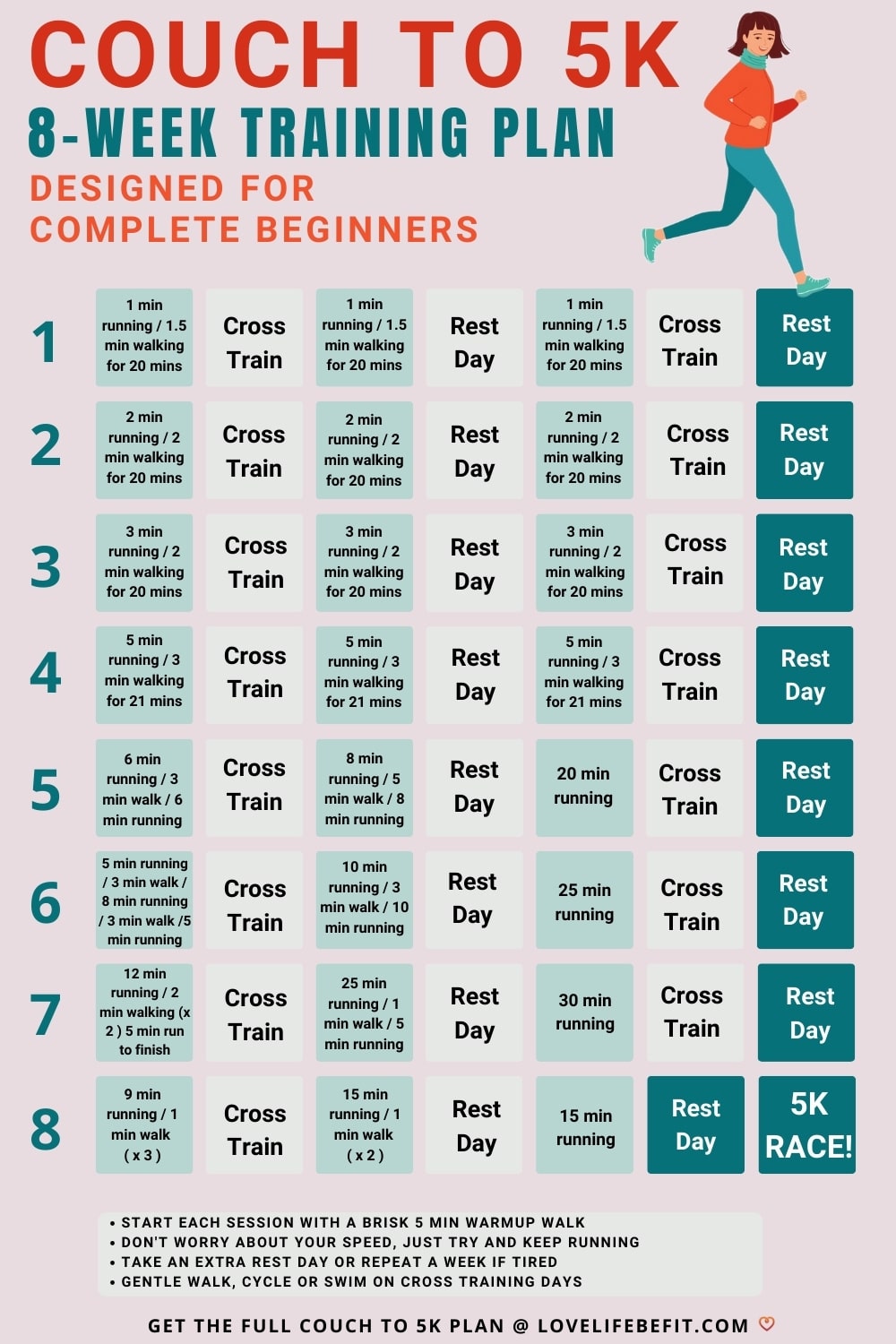
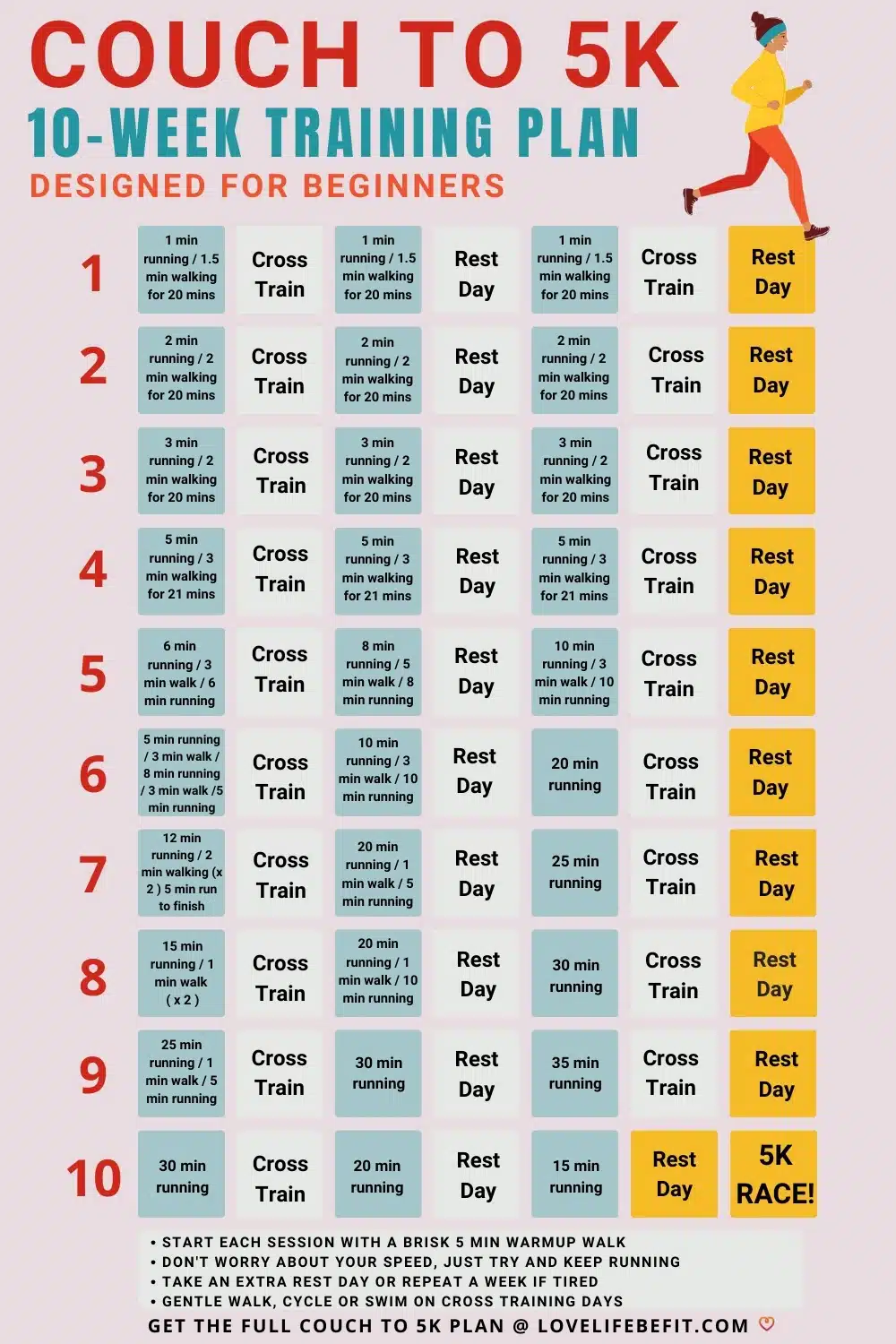
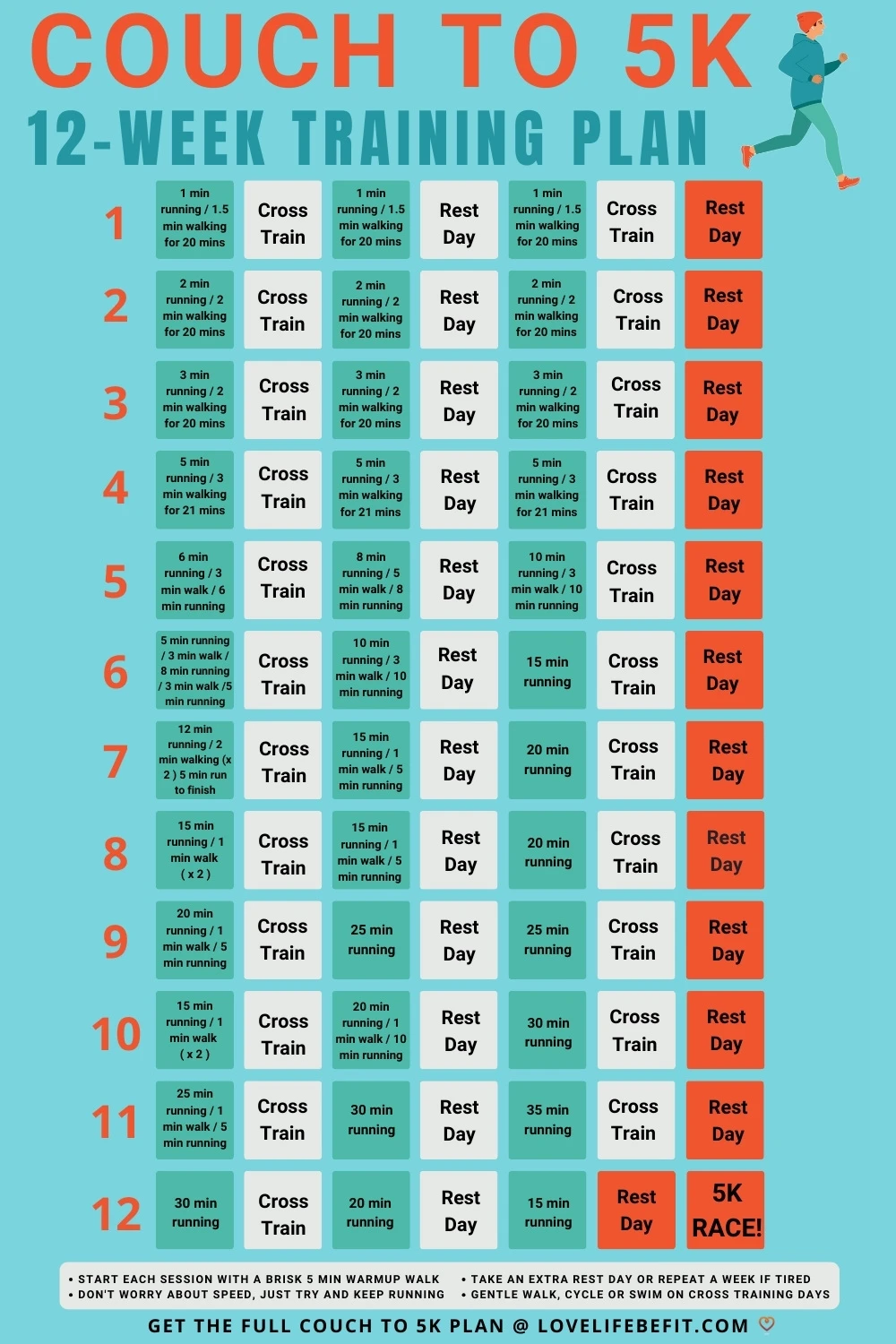
Running 101 Training Guides & Walking Schedules
5K Training Plans
- Couch To 5K Beginner Training Plan
- 12 Week 5K Training Plan
- 10 Week 5K Training Plan
- 8 Week 5K Training Plan
- 6 Week 5K Training Plan
- 4 Week 5K Training Plan
- 5K Training Plan Intermediate




